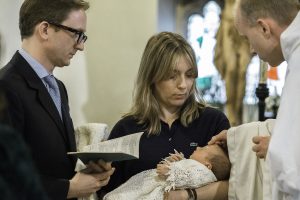Words on the Word
Baptism of Marie-Françoise Keenan
Two days ago, we celebrated Christ’s Ascension, one of the most important feasts in the liturgical year, but one that may leave us perplexed. This is partly on account of ambiguities in iconography. It is difficult for a modern observer to contemplate a great Renaissance painting of the Ascension — a Tintoretto or a Tiepolo — without being subconsciously disturbed by images of Apollo 11 rising from Cape Kennedy. We are left wondering: where did Christ ascend to; by what force did he ascend; and what can it possibly mean to say (as we do in the Ascension collect), that where Christ has gone before we shall follow? No mystery of our faith is more at risk of turning into a cartoon; for that reason we may prefer not to think about it very much.
We can be grateful to Marie-Françoise for giving us a chance to look at the Ascension from a different angle. The sacrament of baptism takes us to the heart of the Easter mystery. It is a sacrament of restoration, enabling us to pursue the full stature of humanity as God intended it at first. Time and eternity were continuous then. Earthly life, envisaged to unfold in an enchanting garden, was a novitiate for heaven, a school to make us ready for beatitude. Lest we think this myth and pious fairytale, let us attend to the deepest stirrings of our heart. Who among us has never felt that life as we know it, even at the height of flourishing, is somehow inadequate to give us what we really long for? Who has never felt an ecstatic thirst for something indefinably greater, faced with which we are at once vulnerable and full of daring?

In a moment, during the prayer of exorcism, I will pray God to free Marie-Françoise from original sin. We may react to this prayer with indignation. What could be a more perfect icon of innocence than this wonder of a little girl? Let’s remember, though, that ‘sin’, as Scripture defines it, is not reducible to ‘guilt’. The Fathers, reflecting on redemption, often spoke of sin as a trauma, a wound; it stands for the inherited load that can make life seem so unbearably heavy; that blurs the edges of good and evil, making choices hard; that overshadows life, even the life of an infant, with the certainty that, one day, we shall die. ‘Sin’ is that position of inherited disadvantage that makes it impossible to soar towards the heights we yearn for.
In his goodness, God has provided a remedy. By this great sacrament, Marie-Françoise will be made light and free, full of noble potential, equipped, through the power of Christ’s Paschal victory, to unmask every deception of evil, and to live beautifully. She will be made ‘a temple of God’s glory’. Her breast will be touched by the ‘oil of salvation’, that her heart may forever be at peace. I will anoint her forehead with chrism and so endow her, in Christ’s name, with royal dignity. The white garment in which she will be robed is a sign of nuptial rejoicing. Today, Jesus Christ, risen and glorified, claims Marie-Françoise for himself. He will never let her go; he will, as long as she lets him, bless and gladden her life to make it fruitful, a hundredfold.
What we are about to celebrate is the opening of heaven upon this young life, only just getting accustomed to the strangenesses and delights of life on earth. The great message of Christ’s Ascension, the culmination of Eastertide, is not that our authentic life is somehow transported from a present here to an unknowable there; it is that the there for which we are mysteriously homesick henceforth surrounds us here. Time’s enclosure in itself is broken open; death’s dominion is cancelled; the kingdom of God is in our midst. This is the reality Marie-Françoise is about to enter. Let us all do our utmost to enable her to reap its choicest blessings. Amen.
